There was no saving Herbie, at least not literally, not after its caretaker saw the unmistakable spread of Dutch elm disease in the upper reaches of its crown. Frank Knight – he’s 101 years old – had held off the ravages of the insect-borne fungus for the last 50 years, treating Herbie with periodic injections and lopping off infected branches as they became visible. But by the summer of 2009, it was time to face the facts. New England’s largest American elm tree, the arboreal pride of Yarmouth, Maine, would have to be taken down before it fell down.
As the tree’s date with a felling crew approached, a group of Yarmouth citizens and long-time Herbie fans made plans to save the tree in a figurative way. Its massive trunk and gracefully sweeping leaders, even its twigs, could be salvaged and turned into bowls, cabinets, coffee tables, candlesticks, clock faces, coasters, pens, and other relics.
A tree that sprouted in 1793 would yield a lot of raw material, and given the inroads Dutch elm disease has made since the 1930s, it’s a species that few American artisans get a chance to work with. Some of the tree’s many limbs were large enough to saw into planks. The rest could be chunked into smaller blanks for bowl turners, candlestick makers, and carvers. A major prize was the thousands of board feet of lumber contained in the trunk, which measured almost eight feet across at its widest point.
And so The Herbie Project took shape. Led by Deb Hopkins, a Yarmouth hairstylist and Knight’s successor as Yarmouth tree warden, the project’s steering committee came up with a plan to spread Herbie’s wealth while simultaneously underwriting an arbor fund to help plant new trees in town. Once Herbie was fashioned into planks and pieces, the wood would be distributed through retail sales to the general public and as gifts to skilled woodworkers. With the gifts, though, there would be one important condition: anyone taking free lumber would have to contribute whatever they made to an auction. Sixty percent of the proceeds would go to the maker and the balance to the town.
It was a classic lemons-into-lemonade strategy, and the only thing that stood in the way was getting Herbie on the ground. The elm stood at the corner of South Maine Street and Yankee Drive, towering over nearby houses, power lines, and the roads themselves. The steady march of the disease had forced Knight to remove limbs and branches here and there over the years, so that by early 2010, Herbie was a somewhat shrunken version of what it had been in its glory days. Still, getting the tree down safely would be a formidable challenge.
It did make a sound
On Tuesday, January 19, 2010, police began roping off nearby streets shortly after six in the morning. The felling had been scheduled for Martin Luther King Day, but a snowstorm had forced a postponement. The new date meant that school children and working people would miss the opportunity to watch the tree come down; still, police were expecting a good crowd nonetheless. The newspapers and local television stations had been running stories about Herbie’s imminent demise for weeks. It was no surprise, then, that two competing television crews set up cameras and unfurled their antennae well before dawn. Reporters clutching cardboard coffee cups went out into the predawn black for periodic live broadcasts for the early morning news, even with nothing much to report.
It’s no little thing to remove a 100-foot-tall tree from a residential neighborhood. Whitney’s Tree Service started taking the tree down, a piece at a time, with the help of a crane. By 10:15, Herbie looked nothing like a stately elm. It was a thick but otherwise unremarkable stub some 25 feet high, its limbs abruptly truncated. If someone had driven down the road and asked for Herbie, New England’s biggest elm, and you had pointed to what was left, they would have asked, “What? That?”
With nothing but a mighty bole remaining, Whitney decided to get it over with and simply drop the tree in the middle of Yankee Drive, right between two nearby houses. Steel cables attached to the trunk would steer its fall. To cushion the road from the enormous weight of the tree, workers positioned old tires in the road and, on top of them, a thick log that would absorb the brunt of the tree’s impact.
At last a Whitney sawyer approached the tree for the final series of cuts, a matador approaching his bull not with a sword but with a Husqvarna 395. The chainsaw, the second largest made by Husqvarna, was equipped with a 52-inch bar, and even from a distance, it looked like a handful. First to go was a wedge from the butt to steer the tree’s fall, something a tree cutter could normally kick out of the way with the toe of his boot. This one required three men and a bucket loader to move. Then came the back cut on the opposing side. Working alternately from both sides of the tree, stopping only to refuel his chainsaw or tighten the chain, the sawyer labored on for nearly an hour and a half as he made his way around Herbie’s 25-foot girth. Finally finished, as the tree balanced on a slender tongue of wood, the exhausted sawyer stepped away.
With a tug from the pair of cables, Herbie moved slightly, as if ruffled by a breeze, then picked up speed and thundered down in a cloud of snow.
The danger safely past, police barriers were ripped away and the crowd made a run for the stump. The few dozen spectators who had stuck it out all morning gathered as Peter Lammert of the Maine Forest Service went to work with whiskbroom and push pins to count the tiny rings of a downed tree bigger than anything he’d seen in his life: for a forester, the tree of a lifetime.
Arriving by car and ushered to a ringside seat, a dignified Frank Knight stood in the snow and looked on. He quietly touched the brim of his cap.
Not your average butt log
It fell to J.D. Sullivan & Sons Lumber of New Gloucester to cut the elm into usable pieces of wood. Ordinarily, this wouldn’t have been a challenge for Joe Sullivan. He had spent more than 10,000 hours at the controls of his bandsaw. His mill has its own kiln where the wood could be seasoned, sheds in which to store it, front loaders to move it, saws and milling machines to do anything required.
Sullivan could handle everything but Herbie’s enormous size.
The tree came in on a flatbed trailer and was dropped in the yard, all 39,700 pounds of it. By then, Sullivan had already cut roughly 2,000 board feet of lumber from limbs that had already been trucked in, some as big as 34 inches in diameter. Sullivan knew all about cutting up elm, but this was an altogether different proposition. Herbie was simply too big to be milled conventionally.
Sullivan had two options: slice up the butt log with a chainsaw just as monstrous as the one that was used to take the tree down, or get his hands on something called a Lucas Mill, of which there are three in the state of Maine. It turned out that he did a little bit of both.
To reduce the tree to manageable pieces, Sullivan borrowed a big chainsaw and set his son to work cutting up the log into shorter lengths, and then ripping what was left lengthwise into pieces that could be manhandled onto his bandsaw. They left the butt end of the log intact: 10 feet long, and 94 inches across at its widest point.
After some trouble, Sullivan tracked down the owner of a Lucas Mill in Kingfield. Rob Sawyer had originally bought his Lucas for custom sawing but subsequently veered into the shed-building business. Still, he agreed to bring the portable sawmill to Sullivan’s and have a crack at Herbie. And so it was that early one January morning, a truck bearing Sawyer and three of his sons rattled into the frozen yard towing the mill.
There isn’t a great deal to a Lucas Mill. It’s basically an aluminum frame that supports a carriage on which a gas-powered circular saw is mounted. The carriage rides back and forth on two aluminum beams, making a horizontal slice into the tree on one pass and a vertical cut on the next as the blade is rotated, freeing the plank. Because the mill beavers away at the edge of the log and never has to cut all the way through it, a blade only 16 inches in diameter can reduce an eight-foot thick log into a stack of boards.
In the first few passes, the blade struck nails that had been buried in the trunk over the years, each time bringing everything to a stop as the blade was sharpened and the metal shards located and removed. Sullivan stood by, watching what little apparent progress was being made without saying much. But the unflappable Sawyers prevailed, and within a couple of hours, the saw was moving briskly back and forth, the boards peeling off one after another, with Sawyer’s eldest son dancing down the length of the tree behind the carriage, and the boards being whisked away by his father to a steadily growing stack nearby.
All day the saw ran, and all the next day, from morning until well past dark. They cut up everything save a single, colossal slab four inches thick, 10 feet long, and more than four feet wide. Sullivan put it under cover in a shed. It was a piece of wood worthy of George Nakashima, a spectacular table if the wood could be cured without cracking and if someone could figure out a way to mill it to final shape.
Nothing was wasted
By the middle of February, The Herbie Project organizers were ready to start earning back the $40,000 it had cost to remove, mill, and kiln dry the tree. The colossus had morphed into 6,000 feet of useable lumber (think of a 10-foot-long 2x6 – it’s the equivalent of 600 of them), a half-dozen coffee-table sized rounds, a heap of limb ends as thick as a man’s waist, even a pile of sticks and twigs in which a pen-maker or someone in need of a new walking stick might find something of value. Nothing was thrown out. Even the sawdust had potential use as the raw ingredient for Herbie paper.
Herbie went on sale the morning of February 20th. Sullivan’s crew had neatened up the yard for the occasion, and donned fresh blue jackets with their names stitched in white over the right breast. Inside a cavernous shed, Sullivan’s wife, Dot, and a variety of Herbie volunteers had laid out a table of food. There were cardboard cartons of coffee, crock pots of stew, a plate of cookies, and a freshly baked breakfast cake.
At 10 o’clock sharp, buyers who had left their cars in a lot near the road were permitted to walk down the frozen drive to the mill. Men in orange vests waited. Clamped to their clipboards was a formula for calculating the value of Herbie’s parts and pieces.
Planks were going for $8 a board foot, pricey for green lumber. But that wasn’t as expensive as what The Herbie Project hoped to get from a half-dozen rounds more than two feet across: $500 a pop. Bowl turners were getting a better deal, buying wood by the cubic foot. But how do you establish the value of a pile of twigs, the kind of cellulosic refuse most Mainers would simply burn? Chris Becksvoort, a New Gloucester furniture maker who found himself in charge of the wood distribution, was trying to sort that out even as buyers closed in. “Give them a break,” he instructed the team.
Becksvoort hadn’t envisioned himself as running the wood-to-furniture end of things. But he’d had a fateful conversation with a member of The Herbie Project committee during a workshop he taught at the Shaker village at Sabbath Day Lake. “He mentioned to me they were thinking of cutting up some of the branches and making them into coasters and cookies, and making key chain [fobs] and bottle stoppers,” he said.
Instead, Becksvoort suggested the committee think along more ambitious lines, using Herbie in the same way that a giant oak in England had been distributed to artisans in the “Onetree” project.
“I suggested this to folks on the committee,” he said, “and they said, ‘Oh, good idea. Go for it.’ I’ve been up to here in Herbie ever since.”
A second life
As 2010 wore on, Herbie’s story was being completed in scores of Maine workshops. By midsummer, Becksvoort had started working on three small wall cabinets and a music stand. He had managed to talk nearly 70 artists, furniture makers, turners, and other artisans into taking parts of Herbie and making something for the auction.
Given its near-elimination by Dutch elm disease, American elm is not a species that many woodworkers have a chance to work with. But anyone who’s ever tried to split elm into firewood knows how contrary it can be – its unpredictable, interwoven grain creates challenges unknown with straight-grained species.
Becksvoort has spent 40 years making furniture by hand, one piece at a time, and using hand tools is second nature to him. But he’s used to working with cherry, and the elm was proving to be a different experience.
One steamy July afternoon, Becksvoort was cutting dovetails in a stack of elm cabinet parts – a process that involves defining the interlocking parts with saw cuts and then chopping out the waste with a mallet and chisel. A couple of solid whacks with the mallet downward were followed by careful tapping with a chisel to free a chip.
In cherry, the grain might have run straight, slightly up or slightly down, but it would have been predictable once Becksvoort understood which way it was running. That’s not the case with elm. “Elm’s a bitch,” he said with a smile. “The grain runs up and down and back and forth. It makes it quite a bit more difficult than cherry or pine. Hand planing is very difficult. It can be done, but it’s a real pain in the neck.”
“But it hasn’t been as bad to work with as I thought it would be,” he added. “Elm is elm. It’s going to have that interwoven grain. But the end result is just beautiful. And this is such an historic piece. I mean, 1793. That was George Washington’s second administration.”
As Becksvoort launched into the wall cabinets, other artisans were busy in their own shops. Some of them are big-time players. For example, Jacques Vesery, a renowned turner and carver, was turning a Herbie branch into hollow form vessels that would be decorated with the intricate carvings that have become his trademark. Maine sculptor Andreas von Huene was working on a massive branch section.
They, and others, were working toward a mid-November auction where their work would be sold. (Editor’s Note: visit www.northernwoodlands.org for complete auction results.)
It seems a fitting end for a tree that faithfully shaded a neighborhood for two centuries, but it inevitably raises a question: Where’s the new Herbie? Dutch elm disease, which arrived in the U.S. in 1931, ravaged the American elm and wiped out thousands of trees in New England. Yet some still stand. The question is, which one of them can claim the region’s title as biggest?
“That’s a question everybody’s asking,” Lammert said one afternoon as he watched Sullivan’s crew dismantle the tree. “We never had a second tree listed in elms because Herbie was so big. He was living on and on and on. So this summer, all the arborists and all the foresters will be out looking for Herbie’s successor.”
And Frank Knight, Herbie’s faithful caretaker? He lives by himself in Yarmouth, hardy for a 101 year old, but still facing the frailty that 101 years brings. Becksvoort says he has been approached by Knight’s family. Would it be possible, they asked, to build Knight’s coffin from Herbie when the time comes?
The Herbie Auction Results
On November 13, 2010, the 217-year-old American elm named Herbie that we profiled in the winter issue of Northern Woodlands went on the auction block. By then, what had been New England’s largest elm had been transformed into nearly 300 hand-crafted pieces of both practical and artistic value.
The auction took place in Yarmouth, Maine, roughly 10 months after the tree was felled. It was a sort of last hurrah for Project Herbie, an initiative spearheaded by a group of local volunteers who had worked for a year and half to see the tree preserved in some form after it finally succumbed to Dutch elm disease.
Organizers made an evening of it. After the doors opened at five, guests wandered through the main lobby of the DeLorme building where they placed bids in a silent auction and helped themselves to tables loaded with food that had been prepared by Herbie Project volunteers.
By 7:30, the 200-plus guests were packed into an adjacent auditorium. Numbered bidding paddles used by hopeful buyers were made from slices of the elm’s limbs.
Arrayed around the guests were all manner of Herbie products: benches, tables, lamps, bowls, an electric guitar, even a mobile made in part from Herbie paper. Craftsmen had agreed to turn over part of the sale proceeds to a town arbor fund.
Among the guests was Frank Knight, who had cared for the tree for 50 years as Yarmouth’s tree warden and who had recently turned 102.
Between on-line sales of Herbie objects prior to the auction, the silent auction, and the live bidding, the committee grossed some $30,000. After paying a variety of expenses, the group hoped to end the year with $25,000 for the arbor fund.
“It’s been a long journey,” said Deb Hopkins, who took over Knight’s role as tree warden and headed up The Herbie Project. “It’s been a lot of work, but it’s been wonderful.”




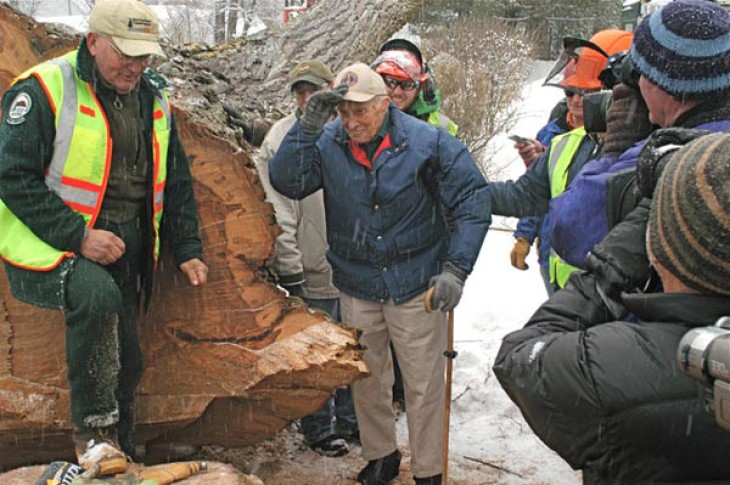
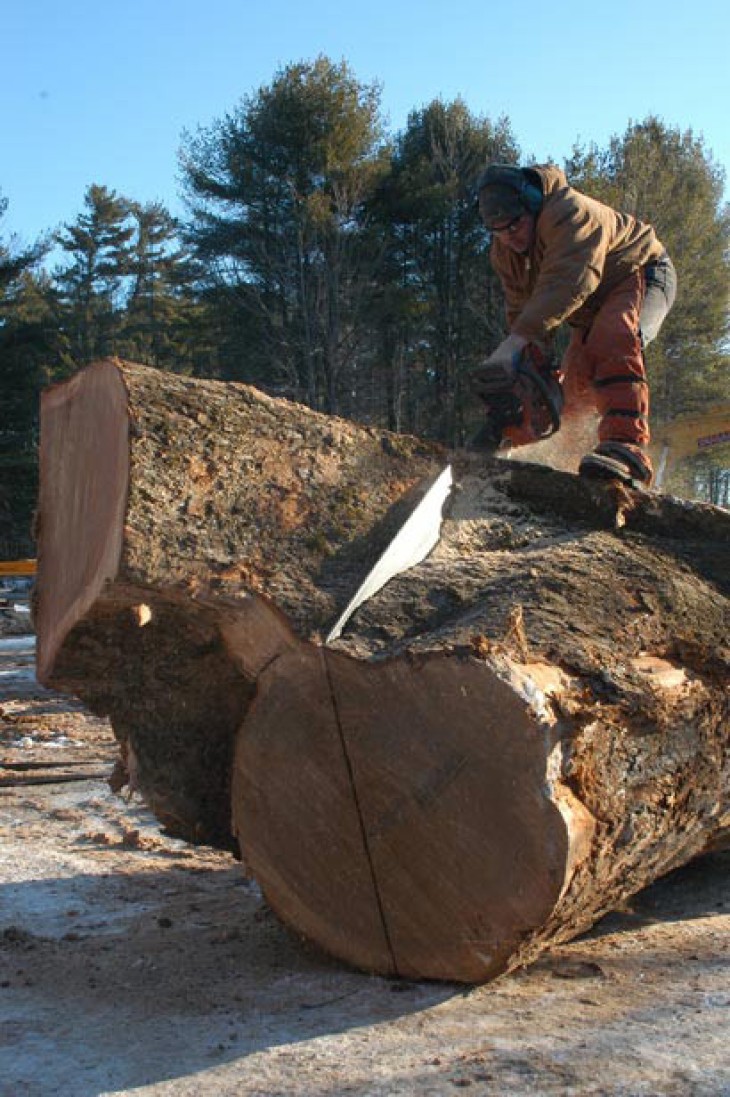


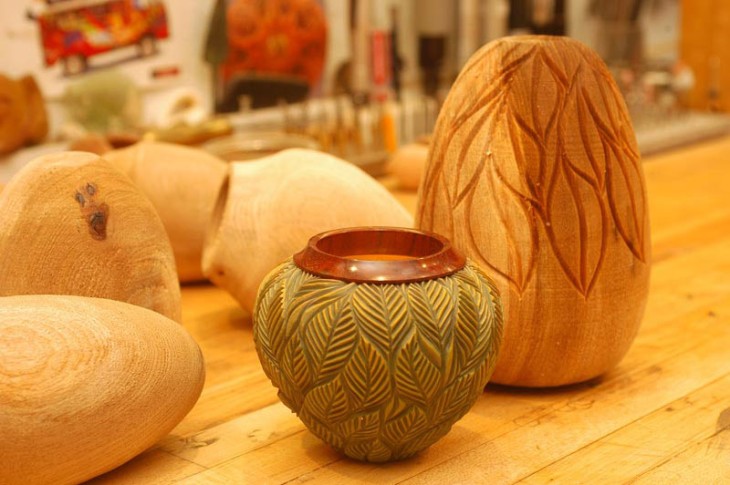


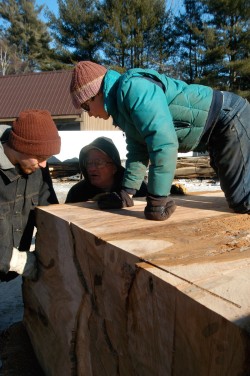
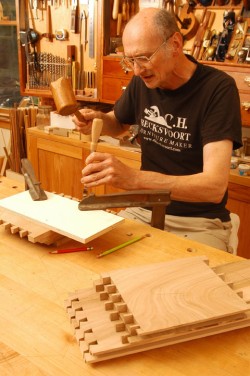
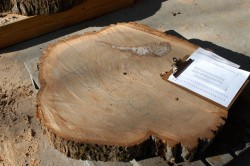
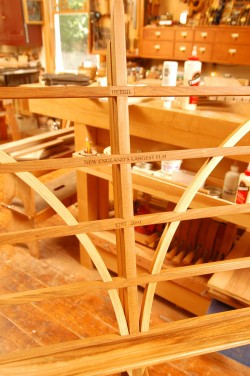
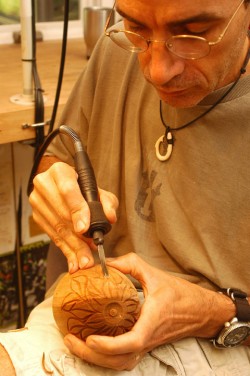
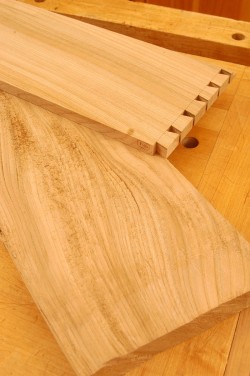
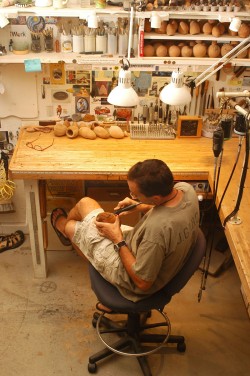
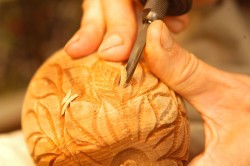
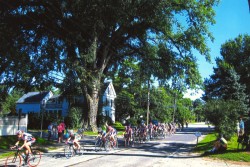

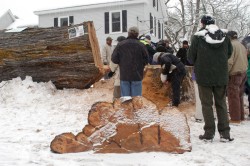
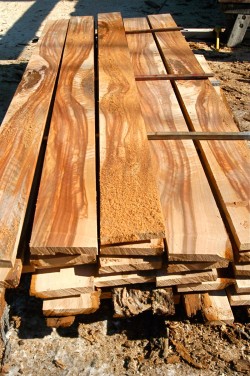
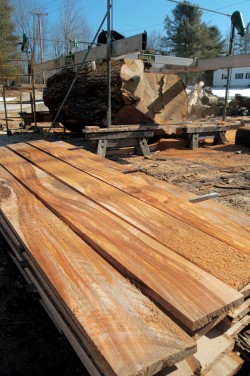
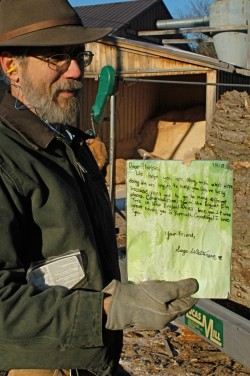
Discussion *